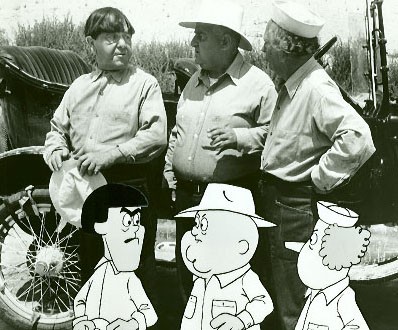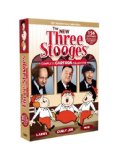| Reviews & Columns |
|
Reviews DVD TV on DVD Blu-ray 4K UHD International DVDs In Theaters Reviews by Studio Video Games Features Collector Series DVDs Easter Egg Database Interviews DVD Talk Radio Feature Articles Columns Anime Talk DVD Savant Horror DVDs The M.O.D. Squad Art House HD Talk Silent DVD
|
DVD Talk Forum |
|
|
| Resources |
|
DVD Price Search Customer Service #'s RCE Info Links |
|
Columns
|
|
|
New Three Stooges - Complete Cartoon Collection, The
But television came to their rescue. In January 1958 Columbia, under their Screen Gems television subsidiary, began distributing classic Stooge shorts of the 1930s and ‘40s to local television stations and the Three Stooges became a bona fide sensation with children heretofore unaware of the team's glory days. This prompted the production of new Three Stooges feature films, mostly at Columbia, movies geared for the kiddie market. Between 1959 and 1965 the team starred in six movies: Have Rocket, Will Travel (1959), Snow White and the Three Stooges (1961), The Three Stooges Meet Hercules (their most successful film), The Three Stooges in Orbit (both 1962), The Three Stooges Go Around the World in a Daze (1963), and The Outlaws Is Coming (1965). More than that, they recorded record albums, guest-starred on various TV variety shows, appeared in a series of comic books, and made hugely popular live appearances all over the country. By 1965 however, Stoogemania had waned a bit, and the Stooges themselves were now getting old (Moe was 68, Larry 63, and Joe 54) and their modest feature films were no longer profitable.
The Stooges manager during this period was a comic book artist-turned-filmmaker named Norman Maurer (1926-1986), who had married Moe's daughter Joan in 1947. Working with Moe, the team's leader behind as well as in front of the camera, Maurer did a pretty good job retooling the Stooges' violent slapstick for their newfound audience and also seems to have been pretty savvy marketing the team in other media. His comic book background is in evidence in several of their feature films, which incorporate animated titles and a strange cinematic innovation he developed, CineMagic, a process intended to make live action footage resemble line drawings, used briefly in The Three Stooges in Orbit and more extensively in the non-Stooge film The Angry Red Planet (1959).
When the Stooges movie career was again petering out, Maurer and Moe decided the next logical step was to move the team into a syndicated cartoon series, which became The New Three Stooges (1965-66). It's not exactly a high-water mark of television animation, and even for Stooge fans it's pretty tough sledding. But the show was unusual in that the team provided their own voices and unique in that they filmed 41 live-action wraparound segments to accompany the 156 cartoons. Though an interesting idea, the imbalance of live-action segments to cartoons created some confusion for viewers, and the show was not a lasting success.
RLJ's "45th Anniversary Collection" release of The New Three Stooges - Complete Cartoon Collection culls all of the cartoon and live-action bits in one neatly compact package, some 18 hours "of knucklehead nonsense," as the back cover describes it. For reasons unknown, the video transfers are rather poor, but compensating this somewhat is a terrific extra feature: a bonus CD containing two of the Three Stooges original records: The Nonsense Songbook and Christmas Time with The Three Stooges.
The cartoon segments are notably short, running an average of 3:25 plus about 50 seconds of animated opening and closing titles, with the live-action segments filling out an additional two-and-a-half minutes or so, resulting in short "shows" running 6:40 each. (Presumably three of these would fill a half-hour time slot.) The brevity of each half allows precious little time for the comedy to build, with each coming off as extremely basic: a short set-up and a bit of clowning. The segment titles are pretty self-explanatory: "Curly's Bear," "The Three Astronutz," "Just Plane Crazy," "Bowling Pinheads," etc. Some of these segments are abbreviated semi-remakes of early two-reel comedies, including The Tooth Will Out, A Bird in the Hand, They Stooge to Conga, and Monkey Businessmen.
Cambria Productions produced the limited-animation cartoons, the studio probably best known for the series Clutch Cargo and Space Angel, shows so incredibly cheap they'd superimpose live-action mouths onto drawn faces, a technique called "Syncro-Vox," to create movement as inexpensively as possible. The New Three Stooges offers a higher grade of animation, about on par with what audiences expected from Rocky & Bullwinkle, Underdog, and Hanna-Barbera's later The Abbott and Costello Cartoon Show (1967-68), which featured the voice of Bud Abbott (though not Lou Costello, who died in 1959).
More interesting are the live-action segments, which were helmed by Edward Bernds, their director on a couple of the last Curly Howard shorts and many of the best featuring Shemp Howard. Bernds came back to supervise several of their later features and meshed well with their broad comic style. Also from the Columbia era, many of the segments feature character comedian Emil Sitka, the actor best known for his doddering old professor characters and who as a bemused Justice of the Peace has the immortal line, "Hold hands, you love birds," a trademark Sitka even had engraved on his tombstone. The live-action segments also feature Margaret Kerry (best known as the model for Tinkerbell in Disney's Peter Pan) while the cartoons feature the voices of Kerry, Hal Smith, Johnny Coons, and the versatile Paul Frees.
Other than the relative novelty of seeing the Stooges perform their shtick in full color, the live-action segments pale compared to the team's best shorts. Joe DeRita lacked the freewheeling energy of Curly and Shemp, while middle Stooge Larry Fine had aged noticeably by 1965 and his timing his rather sluggish and even his speech is a bit slurred at times. Moe, significantly older than both Larry and Curly-Joe, looks his age but ironically has more energy than either Larry or Curly-Joe. On the other hand, while not very funny the segments admittedly have nostalgic value. The team may be a shadow of its former self, but by gamely carrying on in the traditions of long-dead Vaudeville-based slapstick, the Stooges certainly deserved some kind of medal.
The New Three Stooges was the beginning of the end for the team. They attempted something similar to the live-action segments on The New Three Stooges for Kook's Tour (1970), another kids' show, but as they were wrapping up the pilot film Larry suffered a career-ending stroke. He was replaced by longtime supporting player Sitka, and as late as early 1975 the revamped (again) team was to have starred in the low-budget sex comedy, Blazing Stewardesses, but before any footage could be shot Moe Howard died of cancer and the team was finished.
The cartoon show didn't take with kids the way their classic two-reel comedies had, and legal problems kept it out of the public eye when the constant airings of reruns might have helped. To begin with Cambria and Normandy Productions (Moe and Norman Maurer's company) squared off in court over profits from the series, in a lawsuit and appeal not resolved until after Larry's and Moe's deaths in 1975. Years later, the estates of Maurer and Howard battled the estates of Fine and DeRita over royalties and merchandising rights to the team. Against all logic DeRita's heirs wound up with a controlling two-thirds interest in Comedy III, the entity established in 1959 to manage the team's general interests, with the heirs of Larry Fine getting the other third. In the meantime Cambria Productions had long been out of business and most episodes of The New Three Stooges had fallen into the public domain, all of which may account for the poor video transfers here. (The obscure Film Service Laboratories handled the series' lab work and the original film elements may well be lost to boot.)
Video & Audio
The New Three Stooges is presented across four single-sided DVDs. Viewers have the option of playing the complete segments, or without the live-action bumpers, though one would think most would prefer the live-action bits to the cartoons. The picture quality is poor; even on this reviewer's laptop both the live-action segments and the cartoons are soft, murky, and damaged, about PD quality or a bit better than that. The original film elements may be lost or because of all the legal wrangling described above inaccessible to their rights holders. In any case they're marginally serviceable, watchable but little more, and to have all the material compactly collected on discs packaged in casing about the size of two standard DVD cases is a plus. The full screen presentation has okay mono audio and is in English only with no subtitle options.
Extra Features
The lone extra is a good one, essentially two complete records: The Nonsense Songbook, here called "Sing-Along with the Three Stooges," was recorded in 1959, while Christmas Time with the Three Stooges sources a 1983 Rhino Records release culled from the 45rpm The 3 Stooges Sing 6 Happy Yuletide Songs. The team is not in great voice, and one Stooge (Larry?) can even be heard clearing his throat at the beginning of "Play a Simple Melody," but they serve their purpose. My six-year-old, listening to the CD in our car, couldn't get enough of their music and clowning.
Parting Thoughts
The New Three Stooges isn't much more than a footnote in the long (nearly 50-year) career of The Three Stooges (in their various incarnations). It's not a particularly good cartoon show even by unambitious 1960s cartoon show standards, and the live-action segments, while innocuous, aren't even at the level of the least Joe Besser-era shorts. But, for lifelong fans of the team (like this reviewer), The New Three Stooges it's still a welcome release and for them it's Recommended.
Stuart Galbraith IV is a Kyoto-based film historian whose work includes film history books, DVD and Blu-ray audio commentaries and special features. Visit Stuart's Cine Blogarama here.
|
| Popular Reviews |
| Sponsored Links |
|
|
| Sponsored Links |
|
|
| Release List | Reviews | Shop | Newsletter | Forum | DVD Giveaways | Blu-Ray | Advertise |
|
Copyright 2024 DVDTalk.com All Rights Reserved. Legal Info, Privacy Policy, Terms of Use,
Manage Preferences,
Your Privacy Choices | |||||||














